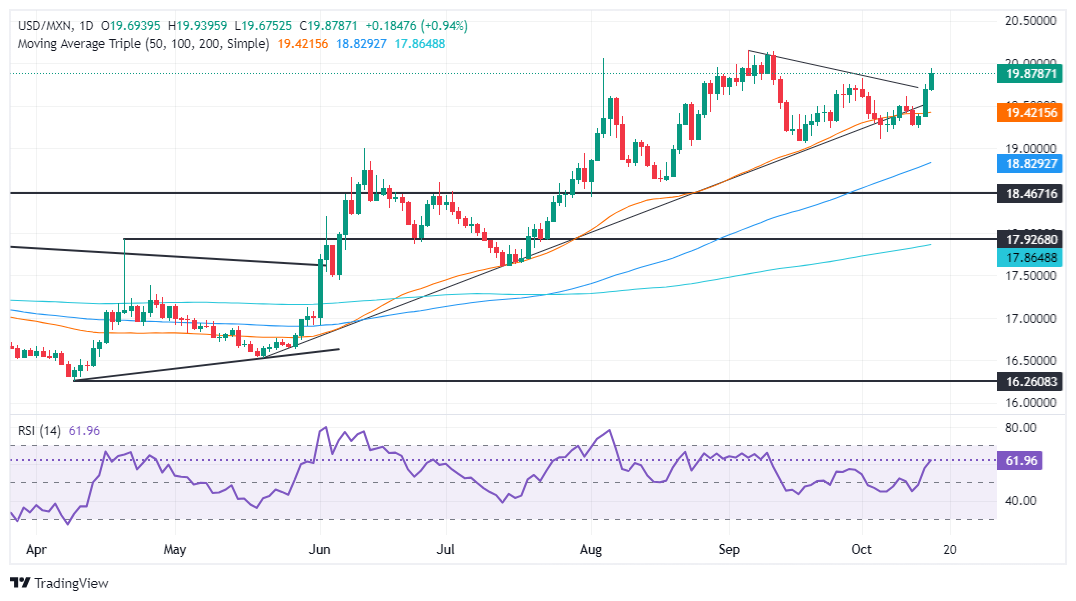- Mexican Peso Weakened as US Dollar Gains Despite Falling US Yields
- The IMF lowers Mexico’s GDP growth outlook for 2024, citing capacity constraints and tight monetary policy.
- US import prices fell sharply in September, while the Fed’s Bostic remains optimistic about meeting the 2% inflation target.
The Mexican peso depreciated in early trading on Wednesday as the US dollar strengthened amid mixed market sentiment with US Treasury yields falling. Softer inflation readings among developed countries suggest that More easing is on the way, indicating the global economy could slow. USD/MXN is trading at 19.87, posting gains of 1%.
US stocks are fluctuating as traders shift their focus to small caps as the Russell 2000 outperforms the NASDAQ and S&P 500. Therefore, risk-sensitive emerging market currencies such as the Peso remained on the lookout .
On Tuesday, the International Monetary Fund (IMF) revised Mexico’s economy downward to 1.5% in 2024 due to capacity constraints and restrictive monetary policy. This is well below the 2.4% estimated by the Ministry of Finance and Public Credit (SHCP).
The IMF estimates GDP growth next year of 1.3% as inflation approaches the Bank of Mexico’s (Banxico) 3% target.
On the US front, the agenda revealed that import prices fell the most in nine months in September due to falling energy prices. Meanwhile, export prices fell in monthly and annual figures.
On Tuesday, Atlanta Fed President Raphael Bostic commented that the US economy is performing well and that he is confident that inflation will reach the 2% target. He does not foresee a recession, although he expects inflation to remain volatile and employment robust.
Later in the week, Thursday’s economic agenda will include the release of Retail Sales, Initial Jobless Claims, Industrial Production and more Fed speeches.
Daily Market Summary: Mexican Peso Plunges as USD/MXN Surpasses 19.80
- Earlier during the North American session, the Mexican Peso hit a five-week low while the USD/MXN hit a high of 19.93, close to the psychological figure of 20.00.
- The IMF said that a recent judicial reform creates “significant uncertainties about the effectiveness of contract enforcement and the predictability of the rule of law.”
- The Banxico survey revealed that economists estimate that the central bank will reduce rates by 50 bp for the rest of the year. The USD/MXN exchange rate is projected to end at 19.69 and the economy to grow 1.45% in 2024.
- US import prices fell -0.4% MoM as expected in September. Export prices plummeted -0.7%, more than the estimate of a -0.4% contraction and less than the -0.9% in August.
- Data from the Chicago Board of Trade via the December federal funds rate futures contract shows that investors are estimating a 50bp easing by the Fed by the end of the year.
USD/MXN Technical Outlook: Mexican Peso Plunges as Buyers Target USD/MXN at 20.00
The USD/MXN uptrend remains intact as the pair briefly broke above 19.90 to hit multi-week highs. Momentum remains bullish as shown by the Relative Strength Index (RSI). This would put upward pressure on the exotic pair, which could break above 20.00 as traders seek safety ahead of the US elections.
The next resistance level for USD/MXN would be 20.00. If broken, the next resistance would be the yearly high of 20.22, before challenging 20.50.
On the other hand, if USD/MXN falls below the support of the October 1 high at 19.82, it could exacerbate a test of the October 10 daily peak at 19.61. In case of further weakness, next support will be the October 4 low at 19.10 before testing 19.00.
The Mexican Peso FAQs
The Mexican Peso (MXN) is the most traded currency among its Latin American peers. Its value is largely determined by the performance of the Mexican economy, the policy of the country’s central bank, the amount of foreign investment in the country and even the levels of remittances sent by Mexicans living abroad, particularly in the United States. . Geopolitical trends can also affect the MXN: for example, the nearshoring process (or the decision by some companies to relocate manufacturing capacity and supply chains closer to their home countries) is also seen as a catalyst for the currency. Mexican, as the country is considered a key manufacturing center on the American continent. Another catalyst for the MXN is oil prices, as Mexico is a key exporter of the raw material.
The main objective of Mexico’s central bank, also known as Banxico, is to keep inflation at low and stable levels (at or near its target of 3%, the midpoint of a tolerance band between 2% and 4%. %). To do this, the bank establishes an appropriate level of interest rates. When inflation is too high, Banxico will try to control it by raising interest rates, which makes borrowing more expensive for households and businesses, thus cooling demand and the economy in general. Higher interest rates are generally positive for the Mexican Peso (MXN) as they lead to higher yields, making the country a more attractive place for investors. On the contrary, lower interest rates tend to weaken the MXN.
The publication of macroeconomic data is key to evaluating the state of the economy and can have an impact on the valuation of the Mexican peso (MXN). A strong Mexican economy, based on high economic growth, low unemployment and high confidence is good for the MXN. Not only does it attract more foreign investment, but it may encourage the Bank of Mexico (Banxico) to raise interest rates, particularly if this strength is accompanied by high inflation. However, if economic data is weak, the MXN is likely to depreciate.
As an emerging market currency, the Mexican Peso (MXN) tends to rise during periods of risk, or when investors perceive overall market risks to be low and are therefore eager to engage in investments that carry higher risk. . Conversely, the MXN tends to weaken in times of market turbulence or economic uncertainty, as investors tend to sell riskier assets and flee to more stable safe havens.
Source: Fx Street
I am Joshua Winder, a senior-level journalist and editor at World Stock Market. I specialize in covering news related to the stock market and economic trends. With more than 8 years of experience in this field, I have become an expert in financial reporting.








